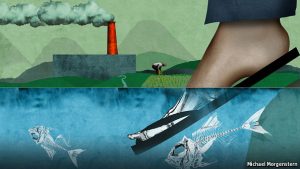
The Communist Party’s inability to control pollution is corroding its authority
The Economist, February 16, 2017
FISHING boats in Dong Hoi, a tranquil provincial capital on the central coast of Vietnam, are decorated with bits of cactus. These prickly charms are said to protect seafarers from storms and other perils, but they did not ward off the misfortune that struck the town last spring. In April the tides spewed thousands of dead fish onto Dong Hoi’s beaches. Authorities dithered for months before naming the culprit: a new steel mill up the coast which had flushed its pipes with toxic bilge.
Nearly a year later, Dong Hoi—like all the settlements on a 125-mile stretch of affected coastline—is still tallying the cost of that calamity. Worst affected are its fishermen, whose red and blue skiffs cluster serenely on the town’s wide river. Some locals refuse to eat their catch, for fear of lingering toxins; others pledge to eat only fish caught far out to sea, or at depths thought to have escaped the poison. Freezers in many seafood restaurants are now stocked with chicken and pork.
The disaster has sapped tourism, too. The town was flattened during the war with America (except for a charred church facade, now preserved as a memorial), but has profited from gargantuan caves discovered on its doorstep. These include Son Doong, said to be the world’s largest, which only opened to visitors in 2013. But last summer hordes of people cancelled their holidays, fearful of splaying out on tainted sand. Half-built hotels and condos dot the outskirts of town, left orphaned by twitchy investors.
Pollution mars many of Vietnam’s stunning landscapes. Dam-building, well-digging and intensive farming are corroding the Mekong Delta, where roughly half the country’s rice is grown. Each year its soil becomes saltier as seawater washes up its weakening streams. Pungent smog smothers Hanoi, the capital. By some counts nearly two-thirds of Vietnam’s industrial wastewater flows into lakes and rivers. In 2015 the authorities identified a score of villages with unusually high cancer rates, perhaps the result of water supplies laced with lead.
A category of environmental trouble not entirely of Vietnam’s making will soon add to this list. With 2,000 miles of coastline, Vietnam is especially vulnerable to climate change. Some estimates suggest that one-fifth of Ho Chi Minh City, its swiftly expanding southern metropolis, could be underwater by the end of the century. Harsher weather and flooding could batter settlements up and down the long seaboard.
Such worries are increasingly seeping into Vietnam’s politics, posing challenges to the repressive rule of the Communist Party of Vietnam (CPV). A government report says that at least 200,000 people were directly affected by last year’s disaster. Some of them have dared to protest at the mill responsible—owned by Formosa, a Taiwanese company—or in front of a local courthouse. They say that the $500m the firm has coughed up in compensation is paltry, and demand the right to sue. Even more striking is the rage among Vietnamese who have not suffered from the poisoning themselves. Shortly after the disaster, a spokesperson for Formosa implied that industry and fishing were incompatible. Demonstrators in Hanoi and Ho Chi Minh City retorted: “I choose fish.”
Nationalism amplifies anger about the environment. In 2014 Formosa’s steel mill was set ablaze by rioters protesting against China’s decision to move an oil rig into contested waters not far from Vietnam’s coast (never mind that Formosa is Taiwanese). Most Vietnamese think their leaders are soft on China, the country’s biggest trading partner but also an old enemy and rival claimant to several islets in the South China Sea. That the party has allowed a (sort of) Chinese firm to poison the coast is particularly galling.
All this is frightening to the CPV, which saw how environmental movements in Eastern Europe buffeted communists there, and which has dealt thuggishly with leaders of the protests. Labelling civil-rights campaigners as stooges for foreign governments is trickier when the party itself is accused of protecting polluters from abroad. In search of new friends to help reduce its reliance on trade with China, the cadres in Hanoi also fret about Vietnam’s reputation. The CPV wants foreigners to see the country as a reliable partner on global issues such as climate change, not as a throwback that reveres a dead leader in a glass box.
So Vietnam’s lawmakers are becoming greener. The country has fairly comprehensive green regulations, reckons Stephan Ortmann, author of a new book on the subject—stricter than those scribbled by China’s rulers, and produced at a faster clip. It has pledged to cull carbon from its economy (though how this squares with plans to build dozens of coal-fired power stations is anybody’s guess). In November the government hosted a big pow-wow on wildlife conservation, obliterating tonnes of confiscated ivory in a satisfying fireball.
A smog of confusion
Yet there is more talk than action, and the government’s shallow coffers are only partly to blame. Economic growth—which in the absence of meaningful elections is the party’s only claim to legitimacy—trumps everything else. Powerful officials in the provinces ignore rules made in Hanoi, and powerful state-owned firms often seem untouchable. A justice system that deals swiftly and ruthlessly with dissidents fails dismally at enforcing quotidian regulation. Whereas smog-fighters in Beijing have begun closing factories and restricting car usage, bigwigs in Hanoi still struggle to prevent scooter-riders from parking on the pavements. Smouldering ire over pollution will make it harder for the party to cope with political or economic shocks.
Dong Hoi’s prospects, meanwhile, hinge on whether the tourists return this summer. The authorities say that the sea is safe for swimming again, but not everyone believes them. A fisherman says he has been back at work for a while, but would not feed his catch to small children for another five or ten years.
Height Insoles: Hi, I do believe this is an excellent site. I stumbledupon …
http://fishinglovers.net: Appreciate you sharing, great post.Thanks Again. Keep writi…
Achilles Pain causes: Every weekend i used to pay a quick visit this site, as i w…

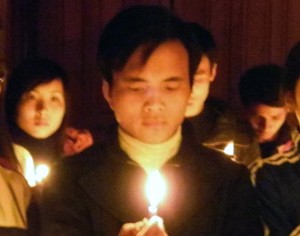
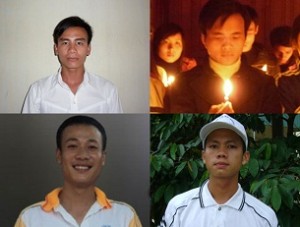
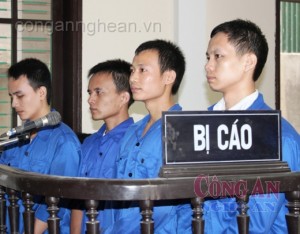

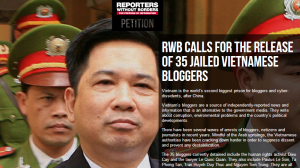
February 17, 2017
Red v green in Vietnam
by Nhan Quyen • [Human Rights]
The Communist Party’s inability to control pollution is corroding its authority
The Economist, February 16, 2017
FISHING boats in Dong Hoi, a tranquil provincial capital on the central coast of Vietnam, are decorated with bits of cactus. These prickly charms are said to protect seafarers from storms and other perils, but they did not ward off the misfortune that struck the town last spring. In April the tides spewed thousands of dead fish onto Dong Hoi’s beaches. Authorities dithered for months before naming the culprit: a new steel mill up the coast which had flushed its pipes with toxic bilge.
Nearly a year later, Dong Hoi—like all the settlements on a 125-mile stretch of affected coastline—is still tallying the cost of that calamity. Worst affected are its fishermen, whose red and blue skiffs cluster serenely on the town’s wide river. Some locals refuse to eat their catch, for fear of lingering toxins; others pledge to eat only fish caught far out to sea, or at depths thought to have escaped the poison. Freezers in many seafood restaurants are now stocked with chicken and pork.
The disaster has sapped tourism, too. The town was flattened during the war with America (except for a charred church facade, now preserved as a memorial), but has profited from gargantuan caves discovered on its doorstep. These include Son Doong, said to be the world’s largest, which only opened to visitors in 2013. But last summer hordes of people cancelled their holidays, fearful of splaying out on tainted sand. Half-built hotels and condos dot the outskirts of town, left orphaned by twitchy investors.
Pollution mars many of Vietnam’s stunning landscapes. Dam-building, well-digging and intensive farming are corroding the Mekong Delta, where roughly half the country’s rice is grown. Each year its soil becomes saltier as seawater washes up its weakening streams. Pungent smog smothers Hanoi, the capital. By some counts nearly two-thirds of Vietnam’s industrial wastewater flows into lakes and rivers. In 2015 the authorities identified a score of villages with unusually high cancer rates, perhaps the result of water supplies laced with lead.
A category of environmental trouble not entirely of Vietnam’s making will soon add to this list. With 2,000 miles of coastline, Vietnam is especially vulnerable to climate change. Some estimates suggest that one-fifth of Ho Chi Minh City, its swiftly expanding southern metropolis, could be underwater by the end of the century. Harsher weather and flooding could batter settlements up and down the long seaboard.
Such worries are increasingly seeping into Vietnam’s politics, posing challenges to the repressive rule of the Communist Party of Vietnam (CPV). A government report says that at least 200,000 people were directly affected by last year’s disaster. Some of them have dared to protest at the mill responsible—owned by Formosa, a Taiwanese company—or in front of a local courthouse. They say that the $500m the firm has coughed up in compensation is paltry, and demand the right to sue. Even more striking is the rage among Vietnamese who have not suffered from the poisoning themselves. Shortly after the disaster, a spokesperson for Formosa implied that industry and fishing were incompatible. Demonstrators in Hanoi and Ho Chi Minh City retorted: “I choose fish.”
Nationalism amplifies anger about the environment. In 2014 Formosa’s steel mill was set ablaze by rioters protesting against China’s decision to move an oil rig into contested waters not far from Vietnam’s coast (never mind that Formosa is Taiwanese). Most Vietnamese think their leaders are soft on China, the country’s biggest trading partner but also an old enemy and rival claimant to several islets in the South China Sea. That the party has allowed a (sort of) Chinese firm to poison the coast is particularly galling.
All this is frightening to the CPV, which saw how environmental movements in Eastern Europe buffeted communists there, and which has dealt thuggishly with leaders of the protests. Labelling civil-rights campaigners as stooges for foreign governments is trickier when the party itself is accused of protecting polluters from abroad. In search of new friends to help reduce its reliance on trade with China, the cadres in Hanoi also fret about Vietnam’s reputation. The CPV wants foreigners to see the country as a reliable partner on global issues such as climate change, not as a throwback that reveres a dead leader in a glass box.
So Vietnam’s lawmakers are becoming greener. The country has fairly comprehensive green regulations, reckons Stephan Ortmann, author of a new book on the subject—stricter than those scribbled by China’s rulers, and produced at a faster clip. It has pledged to cull carbon from its economy (though how this squares with plans to build dozens of coal-fired power stations is anybody’s guess). In November the government hosted a big pow-wow on wildlife conservation, obliterating tonnes of confiscated ivory in a satisfying fireball.
A smog of confusion
Yet there is more talk than action, and the government’s shallow coffers are only partly to blame. Economic growth—which in the absence of meaningful elections is the party’s only claim to legitimacy—trumps everything else. Powerful officials in the provinces ignore rules made in Hanoi, and powerful state-owned firms often seem untouchable. A justice system that deals swiftly and ruthlessly with dissidents fails dismally at enforcing quotidian regulation. Whereas smog-fighters in Beijing have begun closing factories and restricting car usage, bigwigs in Hanoi still struggle to prevent scooter-riders from parking on the pavements. Smouldering ire over pollution will make it harder for the party to cope with political or economic shocks.
Dong Hoi’s prospects, meanwhile, hinge on whether the tourists return this summer. The authorities say that the sea is safe for swimming again, but not everyone believes them. A fisherman says he has been back at work for a while, but would not feed his catch to small children for another five or ten years.